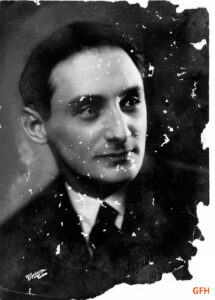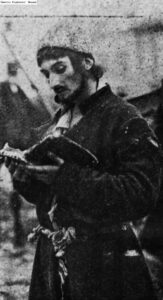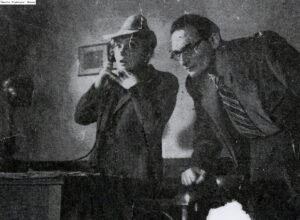Jonas Turkow (15.02.1898 – 1.12.1988)
Actor, director, writer. A prominent figure in the pre-war Yiddish theater. Holocaust survivor.
He grew up in a wealthy, traditionally religious household in Warsaw. His father, Naftali Hersz, was a philanthropist and the founder of a foundation that helped orphans. Jonas abandoned religion as a teenager, attended high school, and later studied acting at a drama school. He began his acting career in 1915, performing in several Jewish theaters alongside his brother Zygmunt, who was also an actor and theater director. In addition to Zygmunt, his other brothers—Icchak and Mark—and his sister Ruta also chose careers in the performing arts.
 Jonas Turkow in 1938. The Ghetto Fighters’ House Archives Israel, Jonas Turkow collection.
Jonas Turkow in 1938. The Ghetto Fighters’ House Archives Israel, Jonas Turkow collection.
In the 1920s, he led theater troupes and organized tours for Ida Kamińska’s theater company in Poland, allowing residents of small towns to experience theater. He met actress and singer Diana Blumenfeld in one of these theater groups, and they married in 1923. In 1926, Turkow was invited to become the artistic director of the newly established Krokower Yidish Teater. It was the first Yiddish theater in Poland to receive funding from the city government. It was also the first to adapt European theater works into Yiddish, including plays by Ben Jonson, Georg Kaiser, and Stanisław Wyspiański. In 1929, Jonas founded the Warsaw New Jewish Theater, and three years later became the director of the new Vilner Yidisher Teater and the Vilnius theater school. He simultaneously acted in films in both Yiddish and Polish. In 1929, he directed the film “In di Pojlishe Welder” (“In the Polish Forests”).
He was in Warsaw when the war broke out. Together with his wife Diana and daughter Margarite (born 1933), they found themselves in the ghetto. The family lived on Nowolipie Street 53, while Jonas worked at an office on Orla Street 6, where he headed the Central Event Commission (CKI) of the Jewish Social Welfare. CKI organized charitable cultural events and provided financial support and legal protection to artists. He was also one of the collaborators of “Oneg Shabbat”—an initiative led by Emanuel Ringelblum—working on preserving the history of the Warsaw Ghetto.
In addition to his work at CKI, he was an active actor and director in the ghetto, collaborating with the Femina Theater, the New Chamber Theater, Melody Palace, and JIKOR (an underground association promoting Yiddish culture). In November 1941, the premiere of the play “Freud’s Theory of Dreams” was held at the Main Judaic Library on Tłomackie Street 5, starring Turkow and Blumenfeld. They had previously performed the play before the war with success. This time, under German censorship, the performance was titled “Comic Dialogues of the Jew, Sigmund Freud.” In March 1942, the premiere of the play “Matura” by Ladislaw Fodor, directed by Jonas Turkow, was held at the Femina Theater, with his wife playing the lead role. The Jewish newspaper “Gazeta Żydowska” wrote: “The much talked-about play by W. Fodor, ‘Matura,’ is enjoying immense success. Every evening, the theater hall is filled with crowds of spectators. Such a magnificent performance has not been seen in our district in a long time. The entire production was masterfully directed by Jonas Turkow.”
He endured moments of horror at Umschlagplatz after his wife and daughter were sentenced to deportation during a selection. In July 1942, after the start of the Great Aktion, Turkow and his wife found work in a workshop on Mylna Street. During a selection on the courtyard of the workshop, Jonas was allowed to remain in the ghetto, but his wife and daughter were sent to deportation. Turkow didn’t want to be separated from his family and asked if he could go with them. While marching to Umschlagplatz, he noticed a familiar policeman and pushed his 9-year-old daughter, Margerita, toward him, shouting, “Save her!”
The policeman took Margerita by the hand and led her in the opposite direction. Soon after, Jonas and Diana found themselves at Umschlagplatz. However, the head of the Jewish district police noticed them among the people and took them out, and hid them in a nearby hospital. A few hours later, looking through the hospital window overlooking Umschlagplatz, Diana suddenly saw Margerita in the crowd waiting for deportation. After Diana’s hysterical cries, the hospital staff found a man who had managed to save the child.
Soon, the Turkow family began to organize the evacuation of the their daughter from the ghetto. Margerita survived the war thanks to the help of Irena Sendler, who found a hiding place for her. Diana Blumenfeld also managed to escape the ghetto, and for a short time, she lived with Margerita. Jonas remained in the ghetto longer, participating in the uprising. He describes burying a chest on Mylna Street in the ghetto before the uprising, containing documents, memories of the ghetto, and family letters, which he managed to recover after the war. After the uprising, he crossed to the other side of the wall and was sent to a labor camp in Grochów, from which he managed to escape. The Turkow family then hid in Zielonka near Warsaw. After the Soviet forces entered Warsaw, they were reunited with their daughter.
 Turkov on the set of the film‘ Der Łamed-wownik’ (One of the Thirty-Six Righteous), made by H. Szaro in 1925. The Ghetto Fighters’ House Archives Israel, Jonas Turkow collection.
Turkov on the set of the film‘ Der Łamed-wownik’ (One of the Thirty-Six Righteous), made by H. Szaro in 1925. The Ghetto Fighters’ House Archives Israel, Jonas Turkow collection.
After the war, Jonas moved to Lublin, where he became the chairman of the Jewish Union of Writers, Journalists, and Artists in Poland. He hosted the first radio programs in Yiddish, including one for people searching for relatives who had disappeared during the war. Since 1945, he was connected with the Central Committee of Polish Jews, especially with the Jewish Social Court of the CKŻP, established to “cleanse the Jewish society of people who, in one way or another, collaborated with the Nazi authorities during the occupation.” Turkow testified as a prosecution witness in several cases, including against the singer Wiera Gran.
In 1946, Jonas and Diana traveled across Europe, organizing and performing in shows for Holocaust survivors in displaced persons camps after World War II. In 1947, Turkow and his family moved to New York, where he performed in theaters, including in the anti-Hitler drama “Professor Mamlock” at the Landsberg Municipal Theater. He also worked as an archivist at the YIVO Institute for Jewish Research, the largest research center on the Yiddish language. In 1966, he moved with his family to Israel, where he wrote books, published articles in the press, and organized exhibitions dedicated to the Holocaust.
 Turkow and Blumenfeld in the play ‘Freud’s Theory of Dreams’ in the Warsaw Ghetto. The Ghetto Fighters’ House Archives Israel, Jonas Turkow collection.
Turkow and Blumenfeld in the play ‘Freud’s Theory of Dreams’ in the Warsaw Ghetto. The Ghetto Fighters’ House Archives Israel, Jonas Turkow collection.
He is the author of several books, including three volumes of memoirs from the Warsaw Ghetto, which serve as a rich source of knowledge about the events, people, and places of the ghetto; as well as a two-volume biographical dictionary of Yiddish theater people murdered in the Holocaust. These include Azoj es Iz gewen (Yid., “That’s How It Was”), Farłoszene sztern (Yid., “Extinguished Stars”), and Noch der bafrajung – zichrojnes (Yid., “After Liberation – Memoirs”). He passed away in 1988 in Tel Aviv.
Reference list:
- Bułat M, „Krakowski Teatr Żydowski: między szundem a sztuką”, Kraków 2006
- Stowarzyszenie Dzieci Holocaustu, „Dzieci Holocaustu Mówią” vol 5, Warszawa 2014
- „Archiwum Ringelbluma”, tom 5, czesc I, Warszawa 2011
- Archiwum GFH, Jonas Turkow Collection, N 30845, 39483, 30942, 30863
- PAN, „Teatralia na łamach ‘Gazety Żydowskiej’ (1940–1942)” https://journals.pan.pl/Content/127132/PDF/2023-01-RHPP-01.pdf
- Gabriel Finder, „Proces Szepsla Rotholca a polityka kary w następstwie Zagłady” w Zagłada Żydów. Studia i Materiały, Nr 2
- AŻIH, „Spuścizna Jonasa Turkowa Lata: 1922-1946”, S/364

